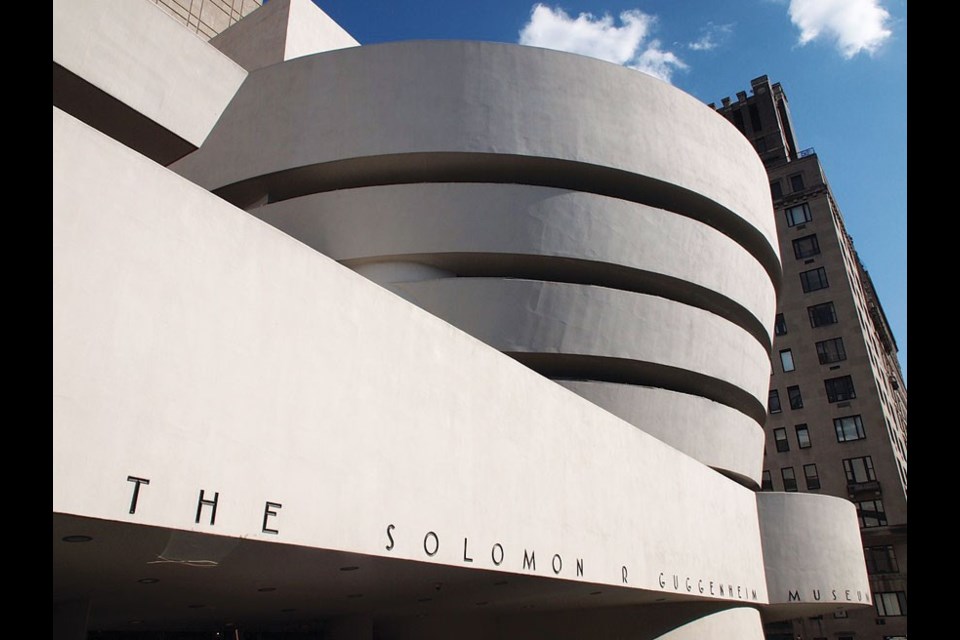NEW YORK, New York. We're in the Solomon R. Guggenheim Museum and have just finished reading an information panel that says abstract artist Ad Reinhardt produced only black—totally black—paintings from 1961 until his death in 1967.
"I bet he died of boredom," says my teenage son Spence, staring at a Reinhardt canvas.
An honest appraisal of what we see is one of the chief strategies Spence, his older brother Shane and I employ to connect with the smorgasbord of art and artifacts we find in New York.
Travel with teenagers is not for the faint of heart, and taking attitude-filled young'uns to multiple museums is not for the unprepared. But what over-worked parent has time to do the research needed to map out a detailed game plan?
Over years of travel with my family I've perfected what I call my "surrender to the experts" strategy. On this NYC trip that means I stride up to the information desk at each of the four museums we visit and ask, "Two teenage boys, two hours, what do you recommend?"
At the Metropolitan Museum of Art the middle-aged information clerk smiles a "Honey, I've been there" smile and pulls out a museum floor plan. Thanks to her suggestions we head straight for the Egyptian galleries and the Temple of Dendur, then up to the Arms and Armor galleries.
We finish our two hours with a wander through paintings by the European masters. "This place is massive," says Shane. "Thanks for not making us see everything."
My sons do want to see everything at the American Museum of Natural History. Not because this is one of the world's greatest museums, but because this is where the movie Night at the Museum was set.
With a movie-related information sheet and map provided by the desk clerk our visit becomes a grand treasure hunt to find the real displays recreated in the film. Highlights include the Barosaurus skeleton in the rotunda, the 29-metre-long blue whale in the Hall of Ocean Life and stampeding elephants, now standing still, in the Hall of African Mammals.
"Overwhelming is an understatement," says Spence. After two hours we fuel up on hot dogs and colas, then spend 90 minutes in the museum's Rose Center for Earth and Space. Final verdict? "Awesome place."
We don't fair as well at the Museum of Modern Art. The information clerk seems unimpressed with my question—"I don't know, maybe the permanent galleries on the fourth and fifth floors?"—and the crowds exhaust us.
Back at the more manageable Guggenheim, we leave Reinhardt's black canvas and walk up the museum's spiral ramp. We're delighted by a temporary installation that sends a little trolley with wings scooting down an elevated track that follows the curves of the ramp from the sixth level to the main floor.
On the museum's audio tour, artist Ann Hamilton explains her inspiration for the installation: "Haven't you always really wanted to get on a skateboard and just, like, ride down these ramps?"
Like, yeah, say the teenagers.
JAMESTOWN, New York || "Vitameatavegamin." The word brings an instant smile to people of a certain age, the people who grew up with "I Love Lucy" on television, either in first-run or in the endless repeats. They smile again when they reach the Vitameatavegamin table in the museum here in star Lucille Ball's hometown, an hour's drive southwest of Buffalo.
They remember the famous episode in the long-running sitcom, where Lucy tries to make a commercial for the titular tonic, not realizing that it contains alcohol, and gets more soused by the minute. Visitors are encouraged to "remake" the commercial, aided by a teleprompter.
Yes, Jamestown loves Lucy, the girl from Stewart Avenue who conquered Hollywood and the hearts of TV viewers with her shows — variously called I Love Lucy, The Lucy-Desi Comedy Hour, The Lucy Show and Here's Lucy —from 1951 to 1974. "They're still being screened in reruns, somewhere in the world, every day, dubbed into something like 20 languages,'' a guide tells visitors.
The museum is called the Ball-Arnaz Center. (Desi Arnaz was Ball's husband and her co-star in I Love Lucy. They later divorced.) It has three components. The main one is the Desilu Playhouse, which is devoted to the various television series. Included are costumes, memorabilia, exact replicas of a couple of the sets and, of course, the Vitametavegamin table.
The second component is the Lucy-Desi Museum, which covers the personal lives of the couple and reminds us that Lucille Ball was anything but the scatter-brained redhead she played on screen. In fact, she was a shrewd businesswoman, the first woman to head a major Hollywood studio (Desilu). Visitors learn how Ball, from an Irish-Scottish-French family, left Jamestown at 15 to make it in show business. It was a long haul: the Broadway chorus line, Chesterfield cigarette advertisements, and 68 B-movies before she became a radio star with My Favorite Husband. This came to TV in 1951 as I Love Lucy.
Exhibits on bandleader and actor Arnaz tell how he and his family fled Cuba when Fulgensio Batista seized power in 1934, and how he and Lucy met and fell in love on the set of the movie Too Many Girls in 1940. They wed the next year; the marriage lasted until 1960.
And finally, the Lucy-Desi Gift Shop is everything you'd expect, crammed with every conceivable Bell-Arnaz doodad: faux Vitameatavegamin tonic bottles, a dozen biographies and picture books, DVDs, magnets, t-shirts, shot glasses, board games...
At the museum you can pick up a map for a self-guided tour of other Lucille Ball sites, such as the Stewart Avenue house where she was born and the family plot in the cemetery on Lakeview Avenue.




